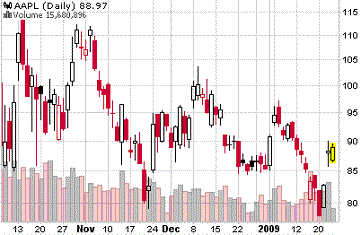This method dates back to the 17th century when the Japanese used this analysis in the rice trade.
You may be asking yourself what exactly pre-electricity lighting has to do with technical stock analysis -- rest assured, candlesticks are a tried and true method of technical analysis. In fact, this method dates back to the 17th century when the Japanese used this analysis in the rice trade. Market historians peg the period of time after 1850 as the origin of candlestick charting, but this method's ancestry lies in charting performed by a rice trader (named Homma) for the town of Sakata.
Let's first take a look at a candlestick chart, then we will examine the different facets of the trading tool. 
Each of the individual bars on the chart are called candlesticks. The empty (or filled) portion of the candlestick is known as the body (a.k.a. the real body). The thin lines extending above and below the body are called shadows, and represent the high/low range for the stock. If a stock advances on the day, the body is hollow (white bars in the above chart) and the bottom of the body is drawn at the opening price and the top of the body at the closing price. If the stock drops, the candlestick is filled (red bars on the above chart) with the top of the body at the opening price and the bottom at the close. The shadows hit the stock's intraday low and high. The shorter the candlestick, the weaker the buying or selling pressure and vice versa. A long white candlestick means a sizeable move, and some believe that a longer white candlestick at the end of a pronounced decline can mark potential support (and the inverse for black candlesticks).
Simple, right? Actually, yes, but there is more to candlesticks than what we have covered. What if you have a Marubozu? This is not some exotic drink, the Marubozu brothers (Black and White) have no upper or lower shadows, meaning the day's high and low were the open and the close. Marubozu are believed to show that the price action was controlled by buyers (or sellers) throughout the trading day.
From no shadow to long and short shadows. A candlestick with a long shadow shows that trading was active throughout the day (no intraday lulls). On the other hand, short shadows indicate that the stock saw the most activity near the open and the close. In addition, a short lower shadow and a long upper shadow indicate that buyers were the overlying force throughout the session, which pushed prices higher. Eventually, the sellers forced the stock's price down from the high to a weak close - creating the long upper shadow (the inverse is also true). Finally, a stock with long upper and lower shadows surrounding a small body is called a spinning top. While a long shadow coupled with a short counterpart suggests a daily reversal, equal shadows hint at investor indecision.
The final aspect of candlesticks we will deal with here is the Doji This candlestick is formed when a stock opens and closes in the same area. Doji look like plus signs and are neutral patterns. That said, a long shadow on one end and a short shadow on the other suggest that sellers (or buyers) tried to take charge but couldn't. The definition of Doji is simple, but it is a complex idea when compared with long candles and short candles. Make sure to study up on these patterns (including the entertainingly named long-legged doji, dragon fly doji, and gravestone doji).
While the basic discussion of candlesticks will end here, there are many more intricate patterns -- each of which could be the subject of its own analysis. The positioning of the candlesticks (on a gap higher or lower) has its own name, and who wouldn't want to investigate formations like the hammer and the hanging man? We will explain some of the more complicated candlestick patterns at a later date.
Price Headley is the founder and chief analyst of BigTrends.com.